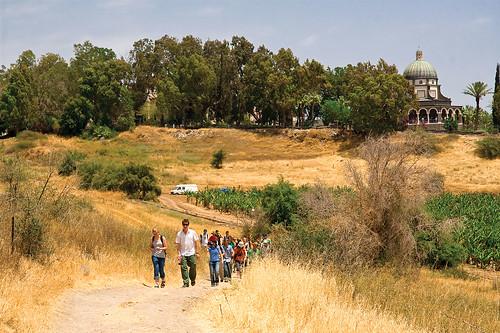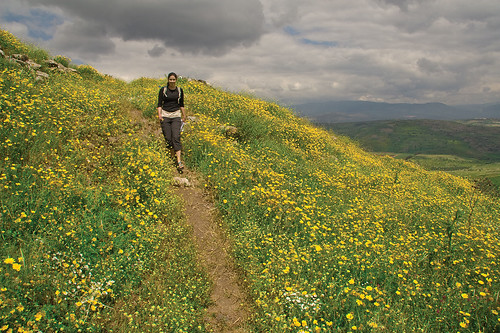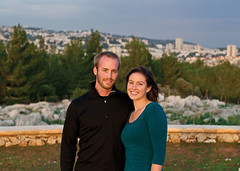By Andrew Jenner ’04, a freelance writer who lives in Harrisonburg. He saw some parts of the Jesus Trail while on an EMU-sponsored cross-cultural semester in 2002.

Student group takes the trail from the Mount of Beatitudes.
It was getting late, it was getting cold, their fire wouldn’t light and they were low on food. Anna Dintaman ’05 and a group of young Jesus Trail volunteers from the U.S. prepared for a miserable night near Mount Arbel.
Then a stranger, a young man who spoke little English, appeared out of the dark and startled the unhappy campers. He looked around their campsite for a minute, before vanishing again into the night. The group’s discomfort gave way to fear.
Before long, the young man returned – with gifts of yoghurt, bread, tea and kindling.
Like the Good Samaritan, like Mary with her expensive perfume, like Zacchaeus in the tree, unexpected lessons from unlikely characters were a major theme of Jesus’ ministry in the Galilee. Two millennia later, the Jesus Trail (jesustrail.com) is giving wanderers and pilgrims the opportunity to learn surprising lessons of their own while walking, literally, where Jesus did.
Conceived in 2007 by co-founders David Landis ’04 and an Israeli friend, Maoz Inon, the 38-mile Jesus Trail from Nazareth to Capernaum has been open to hikers for more than two years. As it attracts increasing international attention, and after it was officially blazed as part of Israel’s extensive trail network last summer, more people than ever before are coming to follow Jesus’ path through the Galilee.
Landis and Dintaman estimate that about 1,000 people hiked all or part of it in 2009. The couple – their wedding is this May (2010) – works full-time developing, promoting and guiding visitors along the Jesus Trail.
While any trip to the Holy Land places familiar Bible stories in geographic context, the Jesus Trail – often hot, steep and rocky – allows hikers to experience the land and the people of the region much as Jesus did. Well-known points along the way include Nazareth, Cana (of water-to-wine fame), Capernaum and the Mount of Beatitudes.
“[People] often comment on how their understanding of Jesus was greatly enhanced by visiting the places he visited and traveling the way that he traveled,” said Kevin Butrick, a 2008 EMU graduate living in Nazareth and a volunteer for the trail.
Yumin Liang, a 23-year-old nursing student from Sydney, Australia, who biked the Jesus Trail last spring, said that was one of the most meaningful aspects of her trip.
“It was really amazing to just picture the Lord Jesus sitting at a spot looking out at the same place we were looking at,” said Liang, who biked with a group of 40 young adults and an ABC camera crew in tow.
Smaller details came alive for Liang, too. At one point, while biking past a field of blooming poppies, the scripture from Matthew 6:29 – “…not even Solomon in all his splendor was dressed like one of these…” – popped into her head.
“The Jesus Trail certainly has a lot of precious places that are conducive to periods of quiet reflection,” she said.
The diverse group of hikers who visit the trail have widely varying motivations and goals – groups like Liang’s on spiritual pilgrimages, Israeli backpackers checking out the new trail, young wanderers looking for a next adventure, honeymooners, a 70-year-old woman, a couple with an 8-month-old baby and many others.
As in Jesus’ day, the modern-day Galilee is a diverse place itself. As it winds from Jesus’ hometown of Nazareth and the lakeshore village of Capernaum, the base for his brief ministry, the Jesus Trail passes through towns and villages inhabited by religious, secular and messianic Jews and Muslims, Christians and Druze Arabs.
That’s another aspect of the trail that allows visitors to gain a better understanding of the world in which Jesus traveled and taught.
“We try to play on that idea of Jesus walking through diverse communities, and give people today an opportunity to do something similar,” Landis said.
Roanoke (Va.) College religion professor Gerry McDermott explored that diversity last fall when he hiked the trail with his son. Along the way, he asked every local person willing to talk a simple question: “What does Jesus mean to you?”
McDermott, who used some of those interviews for an essay about the Jesus Trail published in the April 2010 issue of Christianity Today, said his conversations were “absolutely fascinating.”
Among the many people he spoke to was a Muslim who reveres Jesus as nothing more (or less) than a prophet, a Jew who considers him, simply, a “capable Jew,” a Jew who considers him demon-possessed, a Christian eager to spread Jesus’ message and a Christian reluctant to discuss his faith for fear of persecution.
“Jesus exerts extraordinary power [in Galilee],” McDermott wrote in his article. “Just as he did two thousand years ago, he continues to fascinate the masses, inspire persecuted disciples, and split families and communities.”
Engagement with those communities along the Jesus Trail is a major goal of Landis’s and Dintaman’s. They encourage hikers to spend nights in homes that offer lodging, eat in local restaurants and take advantage of people’s knowledge at points of interest on the route. Those who live along the trail, they said, are generally honored that so many travelers are eager to hike it; Landis and Dintaman frequently hear hikers talk about invitations to coffee and other hospitality they encounter.
The influx of visitors has in turn benefited the local economy. Several new businesses catering to Jesus Trail hikers have opened, and feedback from the towns and villages along the trail has been positive, they said.

Anna Dintaman particularly enjoys hiking rural segments of the Jesus Trail.
From their base in Nazareth, Dintaman and Landis are optimistic that the Jesus Trail’s impact will continue to grow as more and more visitors arrive. By late winter, several hundred people had already signed up for a package tour hike for this spring (2010), and the first Jesus Trail guidebook, which they co-wrote, was published in March. The EMU spring cross-cultural group in the Middle East hiked the trail in April, while emails and phone calls from interested visitors arrive by the day as word of it spreads.
“I believe Jesus is getting very busy on his trail,” said Linda Hallel, another Jesus Trail volunteer. “A lot of people who’ve come and walked were looking to find something, and [they] seem to have found it.”

